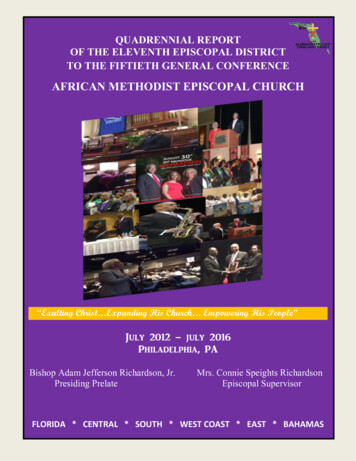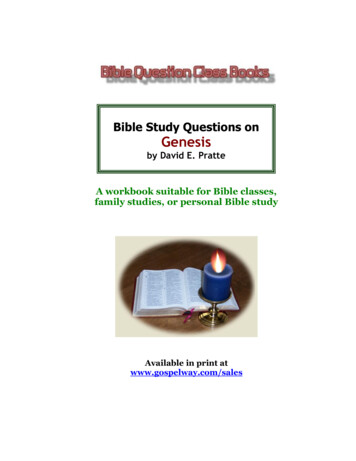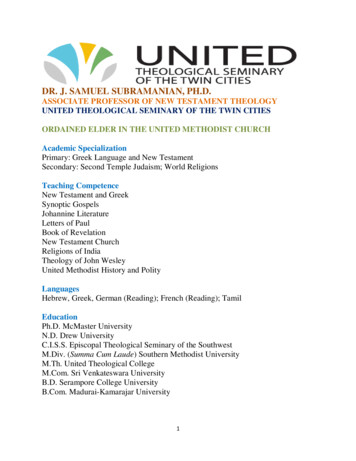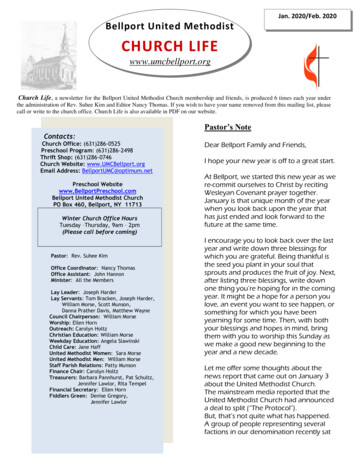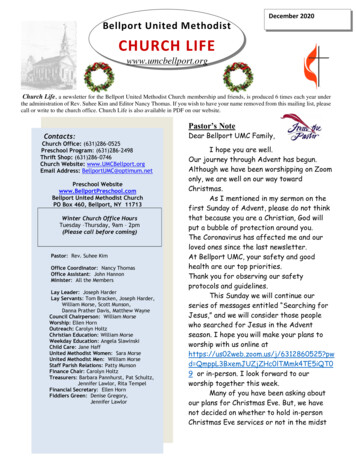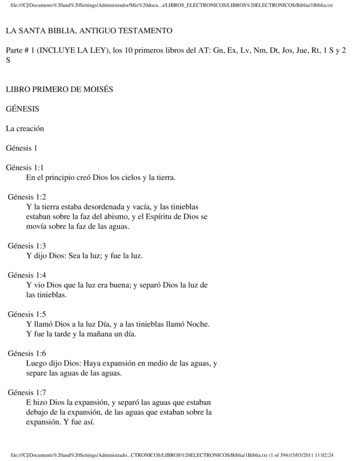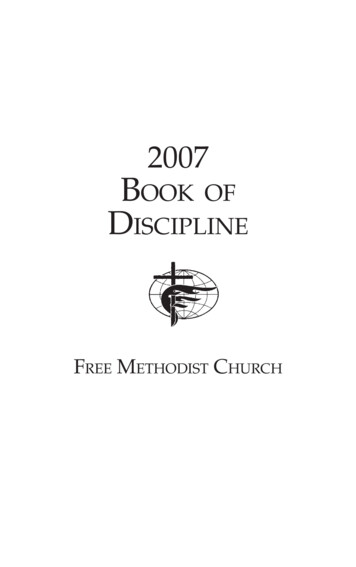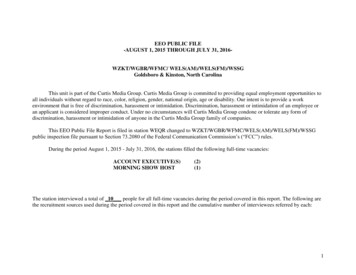
Transcription
The Free Methodist Church – USA2015Book of Discipline“Keep watch over yourselves and all the flockof which the Holy Spirit has made you overseers.Be shepherds of the church of God, whichhe bought with his own blood”(Acts 20:28).
Free Methodist Church – USA 2015 Book of DisciplineThe Board of EditorsBishop David W. Kendall (chair)Bishop David RollerBishop Matthew ThomasDale MartinMarsha RiversWilliam SmoutUnless otherwise noted all scripture quotations are taken from the HOLY BIBLE, NEWINTERNATIONAL VERSION . NIV . Copyright 1973, 1978, 1984 by InternationalBible Society. Used by permission of Zondervan Publishing House. All rights reserved.Copyright 2016The Free Methodist Publishing HouseLight and Life CommunicationsIndianapolis, INPrinted in U.S.A.
ForewordThis 2015 Book of Discipline presents the history, theological roots, and globalcontemporary mission of the Free Methodist Church – USA (FMCUSA). It is theecclesiastical and organizational manual of the church. It includes the CommonConstitution (chapters 1 & 2) of the global Free Methodist Church, of which theFMCUSA is a founding member.The FMCUSA meets every four years for celebrative worship, to align ourselveswith our mission and vision, to address critical issues, and to listen to the Spirit’sleading for the future. In keeping with the Methodist tradition these meetingsare called a “General Conference.”In July of 2015 the FMCUSA celebrated its 37th General Conference in Orlando,Florida. Ministerial and lay delegates from the annual conferences of the UnitedStates and annual conferences of mission origin, together with the bishops,gathered under the banner of “Whole Church.” One responsibility of theGeneral Conference is that it processes any changes to the Book of Discipline,and reviews previous changes which have been approved by its Board ofAdministration. Those changes are included in this 2015 edition.We commend this book to you, not as a dry reference volume, but as acontemporary expression of how this part of the Body of Christ both inspiresand organizes itself for effective ministry under the direction of the Holy Spirit,as together with other Christian traditions we live and serve our Lord in theneighborhoods of our world.– The Editors
Table of Contents2015 Book of DisciplineIntroductionParagraphPagePurpose and Character of the Free Methodist ChurchThe Biblical Concept of the ChurchHistorical Heritage and PerspectiveThe Needs of PersonsDistinctive Principles1255Chapter 1The Constitution of the Free Methodist ChurchPreambleArticles of ReligionMembership100102-131150-1609919General Organization200Restrictive Rules and Methods of Amendment of theCommon Constitution of Free Methodism 210-213General Conferences220-222World Conference230Council of Bishops24023Chapter 2The Constitution (continued)24253035Chapter 3The Christian JourneyThe Goal of the Christian JourneyAs Regards GodAs Regards Ourselves and OthersAs Regards the Institutions of GodAs Regards the ChurchResources for 00373844525962
ParagraphPageChapter 4General AdministrationGeneral Conference Free Methodist Church – USA4000-4080Bishops4100-4200Board of Administration4300-4320Finance and Pension4350-4380Free Methodist Communications4400Free Methodist World Missions4500-4580Free Methodist Foundation4600Chaplains4700Association of Human Service Ministries4750Educational Institutions4800-4860Auxiliary r 5Annual rs5100-5160Standing Boards and Committees5200-5270The Ordained Ministry5300-5340Elder’s Orders5400-5430Conference Membership Transfers and Termination5500-5520Special Cases of Appointments5600-5660Located Deacons and Located Elders5700Evaluation of Ministry r 6The Local ChurchPreamble – Mission and VisionCharacteristicsMembershipLocal Society AdministrationStanding Boards and CommitteesProperty and 0-6460125126127131134140
Local Ministerial CandidatesConsecrated DeaconsPastoral Staff AssistantsFormation of New 1202205Chapter 7Church OrderPreambleHealthy Biblical CommunityReview BoardsConfidentialityProcessing AppealsChapter 8The RitualBaptismHoly Communion:The Sacrament of the Lord’s SupperThe Solemnization of MatrimonyThe Burial of the DeadOrdination of EldersConsecration of DeaconsDedication of ChurchesMinisterial MembershipLay MembershipChapter 9AppendicesArticles of Incorporation of The Free Methodist Churchof North America19000Bylaws of The Free Methodist Church of North America9100209213Index2211 * Although the Church’s corporate name is The Free Methodist Church of North America, by action of theBoard of Administration (April 2011) the Church now does business as The Free Methodist Church – USA.
Mission Statement“To love God, love people, and make disciples.”Vision Statement“To bring wholeness to the world throughhealthy biblical communities of holy people multiplyingdisciples, leaders, groups and churches.”
Purpose and Character of the Free Methodist ChurchIntroductionPurpose and Character of the Free Methodist ChurchThe Free Methodist Church is best understood within the frameworkof the biblical concept of the church, the perspective provided by itshistorical heritage and its commitment to meeting human need.The Biblical Concept of the ChurchIt is clear from Scripture that the church is of God and for people.It is His creation. Christ is its head. The church is the people ofGod chosen for a purposeful partnership in accomplishing thewill of God on earth. More than eighty metaphors, word pictures,relating to the church appear in the New Testament. Each portraysa more profound reality than does the picture it brings to mind. Thepictures together make clear the nature and mission of the church.Paul speaks of the church as “body,” “building,” and “bride.” Themost inclusive and perhaps the most significant metaphor is “bodyof Christ.” The redeemed are spoken of as “members of the body.”What is the profound truth that the many word pictures convey?God – Father, Son, and Holy Spirit – takes a redeemed people intopartnership to share in His activities and to realize His purposes.The church is the organic, corporate instrument God has chosen toremake people and society. It has a mission of holy love. The churchexists to produce Christlikeness in all people and their institutions.Thus our mission may be described as participation with God inbringing holiness and love to bear upon the sins, hurts, and needsof all people. This description of our mission is both individual andsocial. It points to a social relationship of all people to God and toeach other described in Scripture as “the kingdom of God.”The metaphors of the New Testament are made emphatic by thegreatest portrait of all – the Incarnation, God made flesh. Thechurch, enlightened by the Incarnation, continues the teaching andthe ministry of its Lord on earth.When the church is acting under the headship of its Lord and theinspiration of the Holy Spirit, it continues the story begun in thebook of Acts. Many are its wonderful achievements since the firstcentury, and many more may yet be realized in the unfolding dramaof the acts of the Holy Spirit through redeemed people.1
Purpose and Character of the Free Methodist ChurchThe New Testament reminds us that the church visible is not thechurch ideal. Because the church is a divine-human partnership,sharing not only in the holy love of its founder but in the blemishesof its humanity, it is ever in need of renewal. God takes the samerisk with the church in redemption as He did when He grantedpeople freedom in creation. Just as God, the Holy Spirit, used thehands of the Apostle Paul in “special miracles” so He can use Hischurch today. The results will be the same – the Word of the Lordwill grow mightily and will prevail (Acts 19:11 and 20).Historical Heritage and PerspectiveFree Methodists consider the story of the church in the book of Actsand the other New Testament writings as their primary heritage.Generation after generation derives from this record their mainsource of direction and renewal. Followers of God have wrestledwith issues both old and new throughout the centuries just as theydo now. The entire history of the church is instructive for us.Free Methodists claim a line of evangelical descent spelled out inlarge terms as follows: They trace their spiritual heritage throughmen and women of deep personal piety in all ages who have shownthat it is possible to maintain the glow of spiritual fervor in the midstof paganism, apostasy, and the ofttime corruption of the establishedchurch.The lineage of the Free Methodist Church begins with the peopleof God in the Old and New Testaments, and includes influencesand contributions from the multitude of renewal movements inwestern Christianity: Wycliffe and the German Moravians (fromwhom Wesley learned the concept of “the witness of the Spirit”);the sixteenth century Reformation with its many counterbalancingrenewal movements, not the least of which were the Arminiancorrectives (which taught that Christ’s salvation was for allhumankind without limit, but that it must be freely chosen); theCatholic-Anglican tradition; the English Puritan influence; theMethodist tradition; and the ensuing vigorous nineteenth centuryholiness movement. God has used these and others across the agesto make the unchanging Christian gospel known more clearly.In sum, Free Methodists identify with the flow of history of theChristian church while maintaining distinctive evangelical andspiritual emphases.2
Purpose and Character of the Free Methodist ChurchThe contributions from church history may be detailed as follows:The Reformation heritage is reflected in their commitment to theBible as the supreme rule of faith and life, and to salvation by gracethrough faith.The Catholic-Anglican heritage appears in their concern for churchorder and appreciation for liturgical form. Their emphasis on theessentials of the faith allows for their openness towards differingviews on such subjects as modes of baptism and the millennium.The Methodist heritage is shown in theological, ecclesiastical andsocial concerns articulated by the Reverend John Wesley and hisassociates in the eighteenth century and reaffirmed through theholiness movement of the nineteenth.Theologically, they are committed to the Wesleyan-Arminianaffirmation of the saving love of God in Christ. Through prevenientgrace He seeks to bring every individual to himself but grantsto each the responsibility of accepting or rejecting that salvation.Salvation is a living relationship with God in Jesus Christ, giving thebeliever a legal position of righteousness, and therefore affirmingthe security of all who continue in fellowship with Him. Along withthe Arminian emphasis on the universal offer of salvation, JohnWesley rediscovered the principle of assurance through the witnessof the Holy Spirit. He declared a scriptural confidence in a God whois able to cleanse the hearts of believers from sin here and now byfaith, fill them with the Holy Spirit, and empower them for carryingout His mission in the world. John Wesley wrote of himself and hisbrother Charles, “In 1729 two young men in England, reading theBible, saw they could not be saved without holiness, followed afterit, and incited others so to do. In 1737 they saw, likewise, that menare justified before they are sanctified; but still holiness was theirobject. God then thrust them out to raise up a holy people.”Ecclesiastically, the Methodist heritage is continued in FreeMethodist organization. At its most basic level, Free Methodistorganize as local churches and have named them “societies.” In sodoing, they follow early Methodist practice, and designate the localchurch as a transformed and transforming society. The local churchconstitutes a “society” different from the societies of the world.Thus, in the pages that follow, we use the term “society” to refer toFree Methodist Churches in their local settings.3
Purpose and Character of the Free Methodist ChurchThere are lines of responsibility connecting local, district, conference,and denominational ministries. Small groups of believers areaccountable to one another for growth in Christian life andservice. Free Methodists are concerned for the whole church, notjust the local congregation. They value the leadership of bishops,superintendents, pastors, and lay leaders who provide counsel anddirection to the church.Born at a time when representative government was beingdeveloped by free societies, the Free Methodist founders reaffirmedthe biblical principle of lay ministry. Free Methodists recognize andlicense unordained persons for particular ministries. They mandatelay representation in numbers equal to clergy in the councils of thechurch.Socially, from their early days, Free Methodists displayedan awakened conscience characteristic of the early Wesleyanmovement. Their outspoken action against the institution ofslavery and the class distinction inherent in the rental of pews tothe wealthy demonstrated the spirit of true Methodism. Althoughissues change, the sensitive social conscience remains, evidenced bycontinuing active participation in the social concerns of the day.During the nineteenth century, the holiness movement, arising inAmerican Methodism but spreading through other nations anddenominations, called Christians to deeper levels of relationshipwith God and greater concern for the needs of hurting humanity.Within this context, the Reverend Benjamin T. Roberts and otherministers and laypersons in the Genesee Conference of theMethodist Episcopal Church in western New York, raised a protestagainst theological liberalism, unhealthy compromise on pressingsocial issues and loss of spiritual fervor.Between 1858 and 1860, a number of these leaders were excludedfrom the Methodist Episcopal Church on various charges andallegations. In reality, the primary issue was their proclamationof the basic principles of Methodism, especially the doctrine andexperience of entire sanctification. Appeals made to the GeneralConference of May 1860 were denied. Those excluded could notjoin any other Methodist body, for there was none that agreedwith them on the issues on which they were thrust out. Therefore,the Free Methodist Church was organized by a convention of laymembers and ministers which met at Pekin, Niagara County, New4
Purpose and Character of the Free Methodist ChurchYork, on August 23, 1860. The first General Conference met on thesecond Wednesday of October, 1862, at Saint Charles, Illinois.The Free Methodist Church, since its inception, continues to expandaround the world through missionary outreach, the developmentof additional general conferences and a coordinating worldorganization.The Needs of PersonsFree Methodists are committed to the task of understanding themost important needs of persons, institutions and varying culturesso that it may minister meaningfully and redemptively to them. Inthe high priestly prayer of Jesus Christ, He called upon believers tolive in this world actively and intelligently in order that the worldmight be led both to “know” and to “believe.”Free Methodists are aware of the demonic forces in the world whichdebase people, pervert the good and lead people and institutions toruin. They attempt to help people by restoring personal meaning ina time of depersonalizing developments.Free Methodists openly rebuke anything in law, persons orinstitutions which violates the dignity of persons created in the imageof God. They are committed to taking advantage of opportunitieswhere as individuals, societies, conferences and denomination theycan minister healing and redemptive helpfulness in the world.Distinctive PrinciplesFree Methodists seek to express the concept of the church of JesusChrist, their historical perspective and the needs of persons inspecific principles and commitments.Free Methodists today seek to continue the mission of first-centuryChristianity which was recovered by John Wesley and the earlyMethodists who declared they existed “to raise up a holy people.”Free Methodists are a fellowship of Christians in earnest to get toheaven and committed to working in the world for the salvation ofall people. They place their commitment to Christ and His churchabove all others. They keep themselves free from alliances whichwould compete for their highest loyalty and from all which would5
Purpose and Character of the Free Methodist Churchencumber and compromise their effective witness to the Trinitarianfaith and the believer’s dependence upon the grace of God. TheChristian denies himself, takes up his cross daily, and follows Jesus.He conforms to all the will of God as made known in His Word, andbelieves the conditions of salvation are the same now as they werein the days of the apostles.In doctrine, Free Methodists’ beliefs are the standard beliefs ofevangelical, Arminian Protestantism, with distinctive emphasison the scriptural teaching of entire sanctification as held by JohnWesley.In experience, Free Methodists stress the reality of an inner cleansingand power that attests the doctrine of entire sanctification, both inthe inward consciousness of believers and in their outward life.Their worship is characterized by simplicity and freedom of theSpirit, untrammeled by elaborate ritual.Free Methodists maintain a life of daily devotion to Christ that springsfrom inward holiness and separates the Christian from the world, evenwhile he/she lives in the world. They believe the best way to keepworldliness from invading the church is for the church to invade theworld with redemptive purpose.They practice a complete consecration of every power and possessionto the service of God and all people everywhere. They believe sostrongly in the mission of the church that they are committed toresponsible stewardship in finance. Therefore they do not need toresort to commercial efforts to support the cause of Christ.Free Methodists recognize that God gives spiritual gifts of serviceand leadership to both men and women. Since male and female areboth created in the image of God, that image is most fully reflectedwhen both women and men work in concert at all levels of thechurch. Therefore, all positions in the church are accessible to anywhom God has called.Free Methodists sense a special obligation to preach the gospel tothe poor. The provisions of the gospel are for all. The “glad tidings”must be proclaimed to every individual of the human race. Godsends the true light to illuminate and melt every heart. Jesus setthe example. Of His ministry it was reported, “The blind receive6
Purpose and Character of the Free Methodist Churchtheir sight, and the lame walk, the lepers are cleansed, and the deafhear, the dead are raised up, and the poor have the gospel preachedto them.” This preaching to the poor was the crowning proof thatHe was the one who should come. In this respect the church mustfollow in the footsteps of Jesus.Free Methodists are committed to the New Testament ideals ofsimplicity and modesty as a style of life. They wish to call attention,not to themselves, but to their Lord.These distinctives of the Free Methodist Church from its origin arestill living issues. In every era and every land these distinctives arethe witnesses of the church, needing utterance clear and strong thatthey may be heard and heeded amidst the world’s confusing andmisleading voices.7
8
The Constitution of the Free Methodist Church¶100Chapter 1The Constitution of the Free Methodist ChurchPreamble¶100In order that we may wisely preserve and pass on to posterity theheritage of doctrine and principles of Christian living transmittedto us as evangelicals in the Arminian-Wesleyan tradition, insurechurch order by sound principles and ecclesiastical polity, andprepare the way for evangelization of the world and the moreeffective cooperation with other branches of the church of Christin the advancement of Christ’s kingdom, we, the ministers andlay members of the Free Methodist Church, in accordance withconstitutional procedure, do hereby ordain, establish and setforth the following as the Constitution of the Free MethodistChurch.Articles of Religion – GodThe Holy Trinity¶102There is but one living and true God, the maker and preserver of allthings. And in the unity of this Godhead there are three persons: theFather, the Son and the Holy Spirit. These three are one in eternity,deity and purpose; everlasting, of infinite power, wisdom andgoodness.The Son – His Incarnation¶103God was himself in Jesus Christ to reconcile people to God.Conceived by the Holy Spirit, born of the Virgin Mary, He joinedtogether the deity of God and the humanity of humankind. Jesusof Nazareth was God in flesh, truly God and truly human. Hecame to save us. For us the Son of God suffered, was crucified,dead and buried. He poured out His life as a blameless sacrificefor our sin and transgressions. We gratefully acknowledge thatHe is our Savior, the one perfect mediator between God and us.The Son – His Resurrection and Exaltation¶104Jesus Christ is risen victorious from the dead. His resurrected bodybecame more glorious, not hindered by ordinary human limitations.Thus He ascended into heaven. There He sits as our exalted Lord atthe right hand of God the Father, where He intercedes for us until9
¶105The Constitution of the Free Methodist Churchall His enemies shall be brought into complete subjection. He willreturn to judge all people. Every knee will bow and every tongueconfess Jesus Christ is Lord, to the glory of God the Father.The Holy Spirit – His Person¶105The Holy Spirit is the third person of the Trinity. Proceeding fromthe Father and the Son, He is one with them, the eternal Godhead,equal in deity, majesty and power. He is God effective in Creation, inlife and in the church. The Incarnation and ministry of Jesus Christwere accomplished by the Holy Spirit. He continues to reveal,interpret and glorify the Son.The Holy Spirit – His Work in Salvation¶106The Holy Spirit is the administrator of the salvation plannedby the Father and provided by the Son’s death, resurrection andascension. He is the effective agent in our conviction, regeneration,sanctification and glorification. He is our Lord’s ever-present self,indwelling, assuring and enabling the believer.The Holy Spirit – His Relation to the Church¶107The Holy Spirit is poured out upon the church by the Father andthe Son. He is the church’s life and witnessing power. He bestowsthe love of God and makes real the lordship of Jesus Christ in thebeliever so that both His gifts of words and service may achieve thecommon good and build and increase the church. In relation to theworld He is the Spirit of truth, and His instrument is the Word ofGod.The ScripturesAuthority¶108The Bible is God’s written Word, uniquely inspired by the HolySpirit. It bears unerring witness to Jesus Christ, the living Word.As attested by the early church and subsequent councils, it is thetrustworthy record of God’s revelation, completely truthful in allit affirms. It has been faithfully preserved and proves itself true inhuman experience.The Scriptures have come to us through human authors who wrote,as God moved them, in the languages and literary forms of theirtimes. God continues, by the illumination of the Holy Spirit, tospeak through this Word to each generation and culture.10
The Constitution of the Free Methodist Church¶111The Bible has authority over all human life. It teaches the truthabout God, His creation, His people, His one and only Son and thedestiny of humankind. It also teaches the way of salvation and thelife of faith. Whatever is not found in the Bible nor can be provedby it is not to be required as an article of belief or as necessary tosalvation.Authority of the Old Testament¶109The Old Testament is not contrary to the New. Both Testamentsbear witness to God’s salvation in Christ; both speak of God’s willfor His people. The ancient laws for ceremonies and rites, and thecivil precepts for the nation Israel are not necessarily binding onChristians today. But, on the example of Jesus we are obligated toobey the moral commandments of the Old Testament.The books of the Old Testament are: Genesis, Exodus, Leviticus,Numbers, Deuteronomy, Joshua, Judges, Ruth, 1 Samuel, 2 Samuel,1 Kings, 2 Kings, 1 Chronicles, 2 Chronicles, Ezra, Nehemiah,Esther, Job, Psalms, Proverbs, Ecclesiastes, The Song of Solomon,Isaiah, Jeremiah, Lamentations, Ezekiel, Daniel, Hosea, Joel, Amos,Obadiah, Jonah, Micah, Nahum, Habakkuk, Zephaniah, Haggai,Zechariah, Malachi.New Testament¶110The New Testament fulfills and interprets the Old Testament. It isthe record of the revelation of God in Jesus Christ and the HolySpirit. It is God’s final word regarding humankind, sin, salvation,the world and its destiny.The books of the New Testament are: Matthew, Mark, Luke, John,Acts, Romans, 1 Corinthians, 2 Corinthians, Galatians, Ephesians,Philippians, Colossians, 1 Thessalonians, 2 Thessalonians, 1Timothy, 2 Timothy, Titus, Philemon, Hebrews, James, 1 Peter, 2Peter, 1 John, 2 John, 3 John, Jude, Revelation.HumankindFree Moral Persons¶111God created human beings in His own image, innocent, morally freeand responsible to choose between good and evil, right and wrong.By the sin of Adam, humans as the offspring of Adam are corruptedin their very nature so that from birth they are inclined to sin. They11
The Constitution of the Free Methodist Church¶112are unable, by their own strength and work, to restore themselvesin right relationship with God and to merit eternal salvation. God,the Omnipotent, provides all the resources of the Trinity to make itpossible for humans to respond to His grace through faith in JesusChrist as Savior and Lord. By God’s grace and help people areenabled to do good works with a free will.Law of Life and Love¶112God’s law for all human life, personal and social, is expressed intwo divine commands: Love the Lord God with all your heart, andlove your neighbor as yourself. These commands reveal what isbest for persons in their relationship with God, others and society.They set forth the principles of human duty in both individual andsocial action. They recognize God as the only Sovereign. All peopleas created by Him and in His image have the same inherent rightsregardless of gender, race or color. All should therefore give Godabsolute obedience in their individual, social and political acts. Theyshould strive to secure to everyone respect for their person, theirrights and their greatest happiness in the possession and exercise ofthe right within the moral law.Good Works¶113Good works are the fruit of faith in Jesus Christ, but works cannotsave us from our sins nor from God’s judgment. As expressions ofChristian faith and love, our good works performed with reverenceand humility are both acceptable and pleasing to God. However,good works do not earn God’s grace.SalvationChrist’s Sacrifice¶114Christ offered once and for all the one perfect sacrifice for the sinsof the whole world. No other satisfaction for sin is necessary; noneother can atone.New Life in Christ¶115A new life and a right relationship with God are made possiblethrough the redemptive acts of God in Jesus Christ. God, by HisSpirit, acts to impart new life and put people into a relationshipwith Himself as they repent and their faith responds to His grace.Justification, regeneration, adoption, sanctification and restorationspeak significantly to entrance into and continuance in the new life.12
The Constitution of the Free Methodist Church¶120Justification¶116Justification is a legal term that emphasizes that by a new relationshipin Jesus Christ people are in fact accounted righteous, being freedfrom both the guilt and the penalty of their sins.Regeneration¶117Regeneration is a biological term which illustrates that by a newrelationship in Christ, one does in fact have a new life and a newspiritual nature capable of faith, love and obedience to Christ Jesusas Lord. The believer is born again and is a new creation. The oldlife is past; a new life is begun.Adoption¶118Adoption is a filial term full of warmth, love, and acceptance. Itdenotes that by a new relationship in Christ believers have becomeHis wanted children freed from the mastery of both sin and Satan.Believers have the witness of the Spirit that they are children ofGod.Sanctification¶119Sanctification is that saving work of God beginning with new life inChrist whereby the Holy Spirit renews His people after the likenessof God, changing them through crisis and process, from one degreeof glory to another, and conforming them to the image of Christ.As believers surrender to God in faith and die to self through fullconsecration, the Holy Spirit fills them with love and purifies themfrom sin. This sanctifying relationship with God remedies thedivided mind, redirects the heart to God, and empowers believersto please and serve God in their daily lives.Thus, God sets His people free to love Him with all their heart, soul,mind, and strength, and to love their neighbor as themselves.Restoration¶120Christians may be sustained in a growing relationship with Jesus asSavior and Lord. However, they may grieve the Holy Spirit in therelationships of life without returning to the dominion of sin. Whenthey do, they must humbly accept the correction of the Holy Spirit,trust in the advocacy of Jesus, and mend their relationships.Christians can sin willfully and sever their relationship with Christ.Even so by repentance before God, f
This 2015 Book of Discipline presents the history, theological roots, and global contemporary mission of the Free Methodist Church – USA (FMCUSA). It is the ecclesiastical and organizational manual of the church. It includes the Common Constitution (chapters 1 & 2) of the global Free Me
